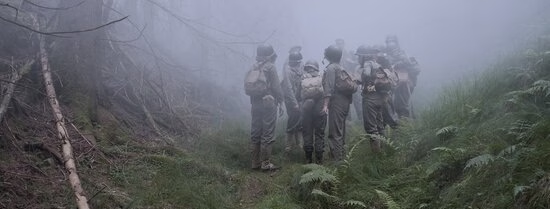Re-enactment groups re-enact historical events such as battles. As a hobby, but also to keep history alive. Lise Zurné from Erasmus School of History, Culture and Communication followed groups reenacting parts of World War II and the Indonesian independence struggle. "You yourself have a voice in how stories are told. That's not the case when you put on a film at home."
Hiking through the Czech Republic at 35 degrees in army uniform with heavy packs and a lead helmet. Lise Zurné did this for her research on historical re-enactment, or reenacting historical events, usually related to war. For her research, she looked specifically at re-enacting events from World War II and the Indonesian independence struggle. She joined mixed groups and groups for women. The women's groups, for example, played nurses from the US army involved in the liberation of Europe.
According to the PhD student, there is a cliché image that mainly middle-aged white men are members of such groups. "That image prevails very strongly, at all that war is something for men. I actually found it interesting to focus on the voices you hear less often in history," she says. So fanatical women's groups do exist, though they are a minority. Indonesian history also intrigued her because you don't hear much about it and, moreover, mainly from the Dutch perspective. "I was very curious about their side of the story. Not so much to find out exactly what happened, but mainly to see how history is dealt with."

The groups find it important to make the reenactment as realistic as possible and sometimes go very far in this, think strict rules of behaviour but also the level of detail in the equipment. According to Zurné, this does not make it a cheap hobby. Through a YouTube video, she found out about the existence of re-enactment groups in Indonesia and travelled that way twice. What surprised her in Indonesia: playing the Dutch was so popular that a stop was needed on the number of participants. "The Dutch have much nicer uniforms and equipment they think, because the Indonesian fighters had to make do with weapons left behind by the Japanese," she says. But of course, the Dutch are always the losing side who are defeated at will."
Heroic role for civilians
Indonesia's political history is sensitive, especially because of Suharto whose regime is seen by many as authoritarian. The participants she spoke to were uncomfortable talking about it. At the same time, she saw back that certain aspects are given extra emphasis by the groups. For instance, the reenactment of the battle of 1 March 1949, about which there are also different versions, puts a strong emphasis on the role of civilians who waged a kind of guerrilla war, while Indonesia's official history is very military-oriented. "For me, it shows that history is fluid. The present influences how we think about the past. So what they are reenacting and highlighting is therefore interesting to explore."
With the female groups in Europe, you can see that they find it important to emphasise the heroic aspect, which they do, among other things, by also carrying weapons. Something male groups then have their doubts about. Anyway, tempers can sometimes run high. During the trek in the Czech Republic, part of the group went back to camp because they could no longer cope given the high temperatures and exhaustion. The rest of the group felt the hardships were part of it and stayed. "They are really strict with each other sometimes and there really is a kind of army discipline. If your uniform is regularly out of place, you can get a scolding. Fortunately, they were more patient with me and often helped me on my way," Zurné says.
Swastikas divisive issue
Discussions also arose over whether or not to display Nazi symbols. Wearing a swastika may be realistic, not everyone feels comfortable wearing it in public. For those who do like to wear it, it sometimes results in them being unwelcome at public events. So while there are social pressures in the groups, a shared fascination with history prevails among members. "Often this starts with watching films, but in time that is no longer enough. They also really want to reenact it. By the way, they often criticise well-known war films. They can list numerous things that are not realistic, from the kind of food to the type of uniform worn."
Democratising history
The PhD student found participating much more fun than she thought she would, although it was also very intense at times. Although historical re-enactment is a relatively small phenomenon, there are several events every weekend in the Netherlands alone. Zurné: "I think it fits a trend of making things tangible and really experiencing things with your own senses. For me as a researcher, it was especially interesting to see what participants find important to emphasise about the past. It is telling history in a small scale. You yourself have a voice in how stories are told. That's not the case when you put on a film at home."
- PhD student
- More information
Through this YouTube video, Lise Zurné found out about the existence of re-enactment groups.
- Related content

